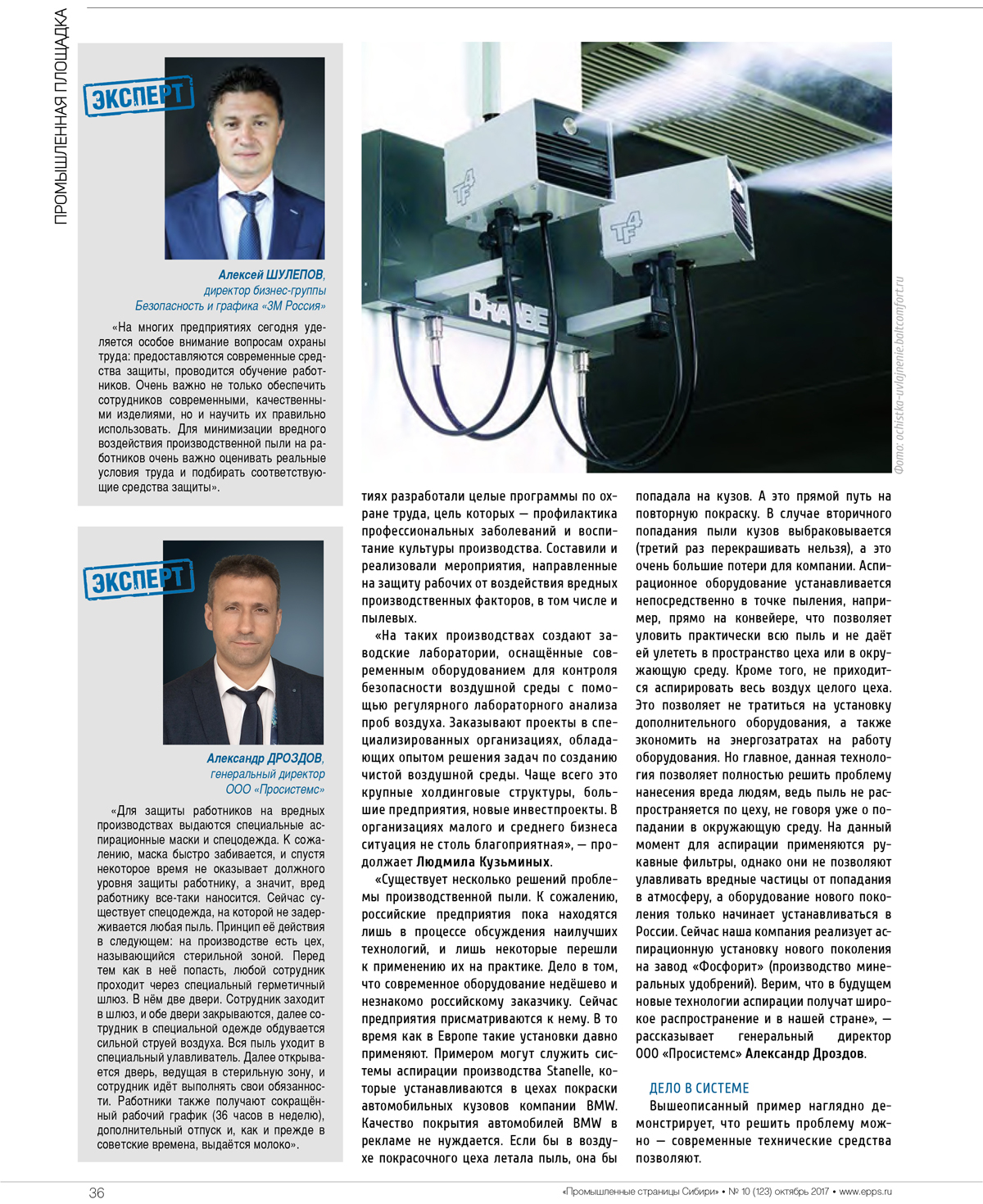COMMENT FROM ALEKSANDR DROZDOV, DIRECTOR GENERAL OF PROSYSTEMS LTD., ON THE PROTECTION OF WORKERS IN HAZARDOUS INDUSTRIES
Comment from Aleksandr Drozdov, Director General of Prosystems Ltd., on the protection of workers in hazardous industries. Promyshlennye Stranitsy Sibiri (Industrial Pages of Siberia) • No. 10 (123), October 2017.
NONDUSTY WORK
The production process at many industrial facilities is accompanied with release of harmful substances into the air inside the industrial halls and outside of them. At the enterprises of the mining and chemical industries, the workers often suffer from industrial dust. The inhabitants of the neighboring districts are also at risk due to the emission of hazardous particles into the atmosphere, which leads to an increased incidence of respiratory diseases in the population.
To protect the workers in hazardous industries, they are given specialized aspiration masks and overalls. Unfortunately, such a mask becomes clogged quickly, and does not provide the due degree of protection to the worker after some time, which means that harm is still caused to the worker. Nowadays, there exists such protective clothing that repels any type of dust. Its principle of operation is as follows: there is a workshop at the enterprise, which is called the sterile area. Any employee has to go through a specialized leak-tight chamber before they can get into it. It has two doors. The employee walks into the chamber, both doors close, and then the employee wearing specialized clothing is exposed to a jet of air. All dust goes into the specialized collector. Then the door leading to the sterile area opens, and the employee proceeds to doing their work. They also work shorter hours (36 hours per week), have an additional vacation and, as before in the Soviet times, they receive milk.
There are several solutions to the problem of industrial dust. Unfortunately, the Russian enterprises are still in the process of discussing the best technologies, and only some of them have proceeded to applying them in practice. The matter is that the state-of-art equipment is quite expensive, and unfamiliar to the Russian customers. Today, the enterprises are just shopping around for such equipment, while in Europe such installations have been in use for quite a long time. An example would be the aspiration systems manufactured by Stanelle, which are installed in BMW’s paint shops where automobile bodies are painted. The quality of coating of BMW’s cars needs no praise. If there were dust drifting in the air of the paint shop, it would deposit on the body. And that would definitely mean re-painting. In case of repeated ingress of dust, the body is rejected (it is not permitted to re-paint it again), and the company incurs great losses. The aspiration equipment is installed directly in the dusting point, for example, right on the conveyor, which makes it possible to collect practically all the dust and does not allow it to be released into the space of the workshop or into the environment. Besides that, it is not necessary to aspirate all air in the entire workshop. This makes it possible to avoid installing additional equipment, and also to save on energy consumption of such equipment’s operation. But the main thing is that this technology allows for completely solving the problem of harm caused to people, as the dust is not spread over the workshop, not to speak of its emission into the environment. There are sleeve filters used for aspiration at the moment, but they do not help prevent the release of harmful particles into the atmosphere, and the new generation equipment just begins to be installed in Russia. Today, our company is selling a new-generation aspiration unit to FOSFORIT”s plant (mineral fertilizer production).
We believe that the new technologies of aspiration will become widespread in our country too in the future.

